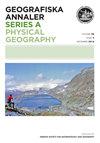Evaluating millennial to contemporary time scales of glacier change in Val Viola, Central Italian Alps
IF 1.8
4区 地球科学
Q3 GEOGRAPHY, PHYSICAL
Geografiska Annaler Series A-Physical Geography
Pub Date : 2018-07-02
DOI:10.1080/04353676.2018.1491312
引用次数: 8
Abstract
ABSTRACT To improve current understanding of ongoing deglaciation dynamics in relation to climatic forcing, it is critical to build long-term series of climate and glacier changes. This task is typically hampered by availability and resolution of Quaternary glacier paleo-reconstructions. To explore opportunities and challenges, we present a case study from Val Viola, which integrates area, volume and ELA changes across a 13k-year time window, including four Younger Dryas–Early Holocene glacier stadials and eight post-LIA periods. Results suggest that relevant shifts in climatic forcing associated with the Pleistocene–Holocene transition and post-LIA deglaciation phases are of comparable magnitude, with an atmospheric temperature increase of about 1.5–2°C. Post-LIA decline in glacierized areas (68.9 ± 6%) is comparable with retreat rates recorded in other Italian glaciers, but is greater than elsewhere in the Alps, where glaciers are comparably larger. Glacier stability in the particularly warm 2007–2015 period testifies to the decoupling attained by small glaciers from synoptic atmospheric conditions. We argue that this is caused by enhanced wind drift and avalanche accumulation, occurred in response to morphological changes on ice surfaces following progressive glacier shrinking. This positive feedback not only could delay glacier extinction in certain physiographic settings but also could introduce bias in paleo-glaciological reconstructions of climatic conditions.意大利中部阿尔卑斯山脉维奥拉谷千年至当代冰川变化的时间尺度评估
为了提高对当前与气候强迫相关的持续消冰动力学的理解,建立气候和冰川变化的长期序列至关重要。这一任务通常受到第四纪冰川古重建的可用性和分辨率的阻碍。为了探索机遇和挑战,我们以Val Viola为例,整合了13k年时间窗口的面积、体积和ELA变化,包括4个新仙女木-全新世早期冰川和8个后lia时期。结果表明,与更新世-全新世过渡和后冰期脱冰期相关的气候强迫变化幅度相当,大气温度升高约1.5-2°C。冰川区在冰期后的退缩率(68.9±6%)与意大利其他冰川记录的退缩率相当,但高于阿尔卑斯山脉其他冰川较大的地区。2007-2015年特别温暖时期的冰川稳定性证明了小冰川与天气性大气条件的解耦。我们认为这是由于风漂和雪崩堆积的加剧,这是对冰川逐渐萎缩后冰面形态变化的响应。这种正反馈不仅可以在某些地理环境中延缓冰川灭绝,而且还可以在气候条件的古冰川重建中引入偏差。
本文章由计算机程序翻译,如有差异,请以英文原文为准。
求助全文
约1分钟内获得全文
求助全文
来源期刊
CiteScore
3.60
自引率
0.00%
发文量
12
审稿时长
>12 weeks
期刊介绍:
Geografiska Annaler: Series A, Physical Geography publishes original research in the field of Physical Geography with special emphasis on cold regions/high latitude, high altitude processes, landforms and environmental change, past, present and future.
The journal primarily promotes dissemination of regular research by publishing research-based articles. The journal also publishes thematic issues where collections of articles around a specific themes are gathered. Such themes are determined by the Editors upon request. Finally the journal wishes to promote knowledge and understanding of topics in Physical Geography, their origin, development and current standing through invited review articles.

 求助内容:
求助内容: 应助结果提醒方式:
应助结果提醒方式:


